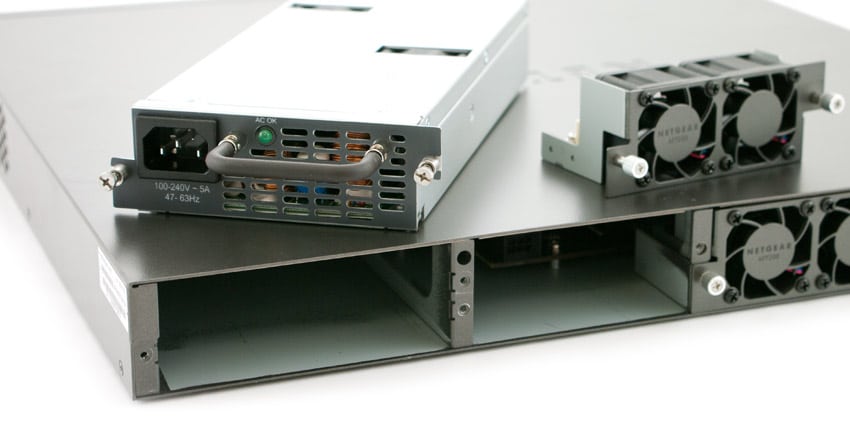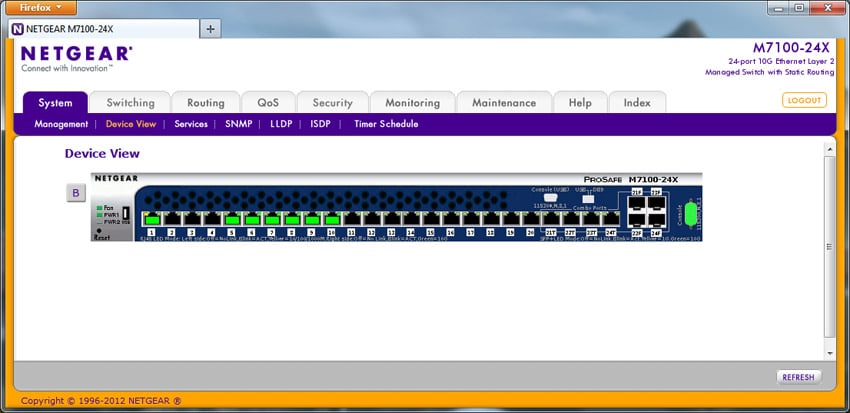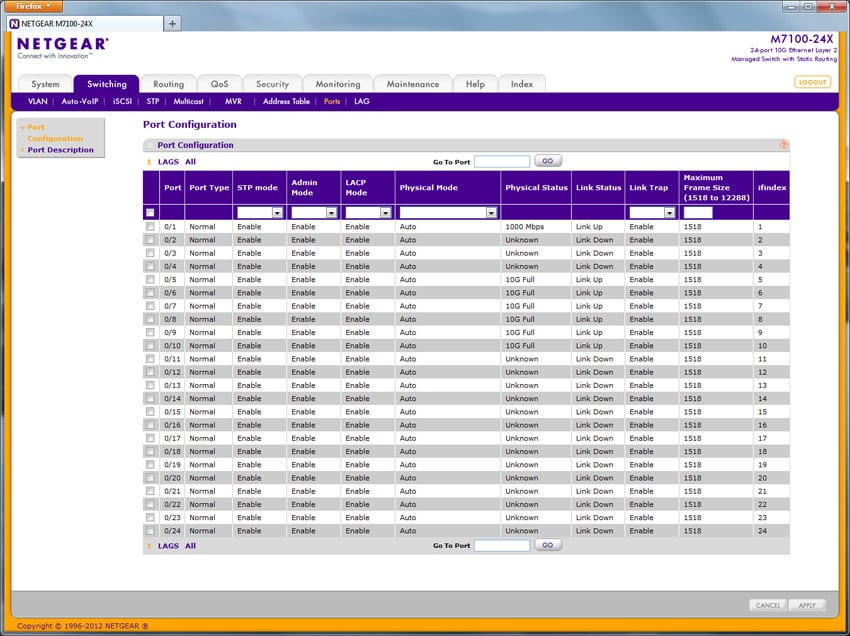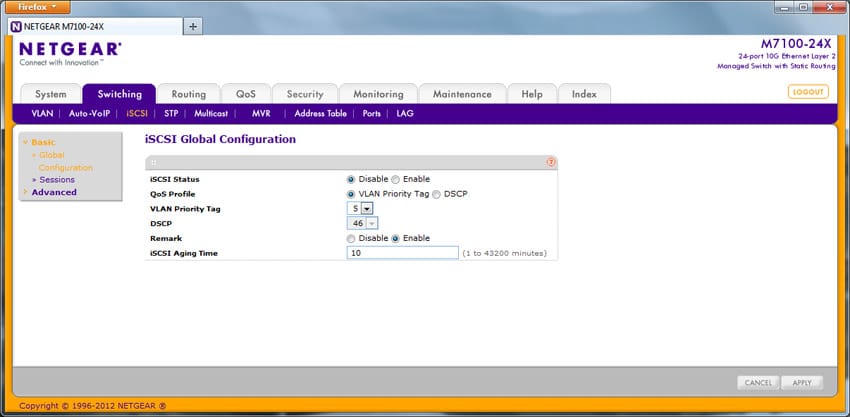
The Netgear M7100 is a fully managed switch that features twenty-four 10GBase-T ports and 4 SFP+ ports and is designed for virtualization and aggregating 10GbE access layer switches. The 24 ports of 10GBase-T use the standard RJ45 Ethernet connection and support Ethernet, Gigabit Ethernet and 10GbE speeds with auto-negotiation for speeds. The SFP+ ports on the other hand extend support further to 1G/10G fiber uplinks and other DAC connections. The M7100 also features an option to purchase an additional power supply for a highly available solution via two PSUs. The M7100’s street price produces a figure close to about $175/port.
Though some large enterprises have been building their IT infrastructures around Fibre Channel or Twinax 10GbE, the advantages in connectivity speeds also come at a significant cost. The M7100’s implementation of 10GBase-T ensures that organizations can meet budget needs and scale as they grow while also benefitting from the backward-compatibility of the 10GBase-T ports which automatically negotiate between lower and higher speeds. This provides a cost-effective solution for organizations that still require performance.
The currently available Netgear M7100 Switch has a street price of around $5,000 which includes lifetime tech support, a lifetime warranty and a three-year warranty for next business day hardware replacement.
Netgear M7100 Specifications
- Processor and Memory
- Processor: Freescale P1011 800Mhz (45nm technology)
- System Memory: 256MB RAM
- Code Storage (Flash): 128MB
- Packet Buffer Memory: 16Mb (Dynamically shared across only used ports)
- Performance
- Switching Fabric: 480Gb/s
- Throughput: 357.1 Mb/s
- Latency
- 64-byte frames, 100 Mb/s, Copper: <8.5 μs
- 64-byte frames, 1 Gb/s, Copper: <2.8 μs
- 64-byte frames, 1 Gb/s, Fiber SFP: <2.5 μs
- 64-byte frames, 10 Gb/s, Copper: <3.7 μs
- 64-byte frames, 10 Gb/s, Fibre SFP+: <1.8 μs
- 24 x 10GBaseT 100/1000/10000 Mb/s RJ45 ports
- 4 ports SFP+ fiber for 1G/10G fiber uplinks and other DAC connections
- IPv4 routing in Layer 2+ package (static routing) with IPv4/IPv6 ACLs and QoS
- Enterprise-class L2/L3 tables with 32K MAC, 6K ARP/NDP, 1K VLANs, 128 static L3 routes
- Power (worst case, all ports used, line-rate traffic): 200W (90VAC@47Hz) max
- Auto-EEE (Energy Efficient Ethernet) associated with Power Back Off for 15-20% less consumption
- Operating temperature: 32° to 122°F (0° to 50°C)
- Dimensions: 440 x 430 x 44 mm (17.32 x 16.93 x 1.73 in)
- Weight: 6.984 kg (15.4 lbs)
- NETGEAR Lifetime Warranty
Design and Build
The Netgear M7100 has a sturdy, rack-mountable design, and it features almost all of the connectivity on the front. Starting from the left side, there are LED indicator lights for both power supplies and the fan. There is also a USB port and a pinhole reset button followed by the 10GBaseT ports which line the front of the unit in six 4-port segments. Above the terminal segment there is the female USB port for console management and a switch to go between serial and USB management. Rounding out the front, on the right side there are 10Gigabit SFP+ fiber ports and the serial port.
The top of the M7100 features Netgear branding, and the sides are ventilated for passive cooling. On the back of the unit, there are either one or two (optional) redundant, hot-swappable power supplies for simplified maintenance. Our test model has one. Additionally, there are two removable fan trays, each with two fans, to cool the entire unit efficiently. The fans can easily be removed using thumb screws for tool-less access.
The M7100 is designed to support rack-mounted installation and comes with a rail kit. To mount the M7100, Netgear includes mounting tabs that extend to fit a 1U mounting slot.
Cost Effective Cables
One of the core cost-savings features of the new 10GBase-T is that they use commodity cables. Compared to a 10GbE solution requiring costly Twinax SFP+ connections with short-reach copper or long-reach optical cables, 10GBase-t switching can utilize off-the-shelf CAT6 (up to 30 meters) or CAT7 (up to 100 meters) cabling depending on the length required.
To put the cabling price in perspective per device connected, a 1 meter SPF+ cable has a street price between $60-$100 depending on brand. That high cost adds up quickly, especially when the comparable 1 meter CAT6 cable can be found with a street price under $1. The other distinct advantage is that if you are receiving new equipment and have no spare cables, you can run to your spool of CAT6 bulk wire and crimp your own cable in a matter of minutes. As companies roll our new high-speed infrastructure in their datacenters, the savings per port with 10GBase-T adds up quickly.
User Interface
Devices in this space generally have their management utilities hosted on their own web GUI, and that is the case with the Netgear M7100-24X. One of the really nice features is being able to easily access a "device view" that enables administrators to have a virtual look at their device. The green highlighter color over a port indicates which ports have connections plugged-in. Clicking any of the connected ports allow users to break out into individual port settings and features.
Similar to the management features of other Netgear switches, the port configuration management option enables each port to individually be configured. STP, Admin, LACP and Link Trap modes can also be enabled or disabled. Physical mode can be switched between legacy and 10G full modes. Additionally, the maximum frame size can easily be configured to set different jumbo frame sizes up to 12k.
The M7100 also features VLAN tagging for prioritization through the management software. That way, administrators can create profiles for types of packets that require more priority or less priority in order to best allocate resources.
Conclusion
The Netgear M7100 10Gbase-t switch provides top-of-rack connectivity utilizing its 24 10GBase-T ports and 4 10G SFP+ ports for highly-virtualized environments or as an infrastructure backbone. The 24 RJ45 ports provide an economical option with cost-effective CAT6/7 cables for organizations that don’t have the budget for copper or optical SFP+ connectivity, but want to leverage more performance. With the ports’ auto-negotiating capability, existing infrastructure can still be utilized to meet specific needs. At the same time, the M7100 also features 4 x SFP+ ports to support 1G/10G fiber uplinks for longer-reach connections.
The Netgear M7100’s addition into the StorageReview Enterprise Lab provides us with plenty of connectivity for upcoming large-scale tests utilizing 10GBase-T, as well as integration with existing high-speed networking fabrics. The M7100 is also simple to manage with its intuitive, well-designed user interface, and it delivers performance necessary for our environment.
Netgear M7100 Switch at Amazon.com







